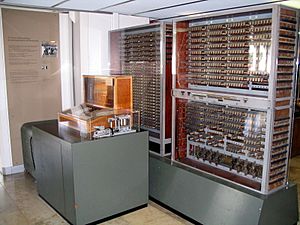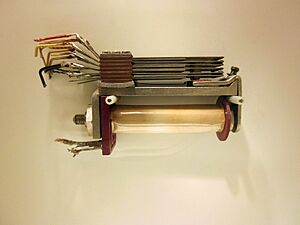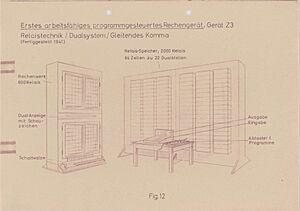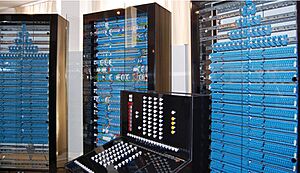Z3 (computer) facts for kids

Zuse Z3 replica on display at Deutsches Museum in Munich
|
|
| Also known as | V3 (Versuchsmodell 3) |
|---|---|
| Developer | Konrad Zuse |
| Type | Programmable, fully automatic digital electromechanical computer |
| Release date | May 12, 1941 |
| Retail availability | 2 years |
| Introductory price | Costs: ca. 50,000 ℛℳ |
| Power | Around 4,000 watts |
| CPU | 2,600 relays @ 5–10 Hz |
| Memory | 64 words with a length of 22 bits |
| Removable storage | Punched celluloid tape |
| Display | Row of lamps to show results |
| Input | Terminal, with a special keyboard for input |
| Weight | Around 1 tonne (2,200 lb) |
| Predecessor | Z2 |
| Successor | Z4 |
The Z3 was an amazing German computer. It was designed by Konrad Zuse in 1938 and finished in 1941. This machine was the world's very first working computer that could be programmed. It was also fully automatic and used digital technology.
The Z3 was built using 2,600 relays, which are like electric switches. It worked with numbers that were 22-bit long. The computer operated at a speed of about 5 to 10 Hz. Its programs were stored on special punched film tape. You had to type in the starting numbers by hand.
The Z3 was completed in Berlin in 1941. It was not thought to be super important for the war effort. So, it was never used for everyday tasks. It helped solve problems for airplane wings, like "wing flutter." This was based on the work of engineer Hans Georg Küssner. Konrad Zuse asked the German government for money to make the computer even faster. He wanted to use electronic switches instead of relays. But his request was turned down during World War II. They said it was "not war-important."
Sadly, the first Z3 was destroyed on December 21, 1943. This happened during an Allied bombing raid on Berlin. The Z3 was first called V3, which meant "Experimental Model 3." But its name was changed to Z3 to avoid confusion with Germany's V-weapons. A working copy of the Z3 was built in 1961. Zuse's company, Zuse KG, made it. You can now see this copy at the Deutsches Museum in Munich.
In 1998, experts showed that the Z3 could, in theory, do any calculation a modern computer can. This is called being Turing-complete. However, it couldn't make decisions based on results, like "if this, then do that." So, it had to guess all possible answers. Then, it would just ignore the ones it didn't need. Because of the Z3 and earlier machines, Konrad Zuse is often called the inventor of the computer.
Contents
How the Z3 Was Designed and Built
Konrad Zuse started designing his first computer, the Z1, in 1935. He built it from 1936 to 1938. The Z1 was a mechanical machine. It only worked for a few minutes at a time. Helmut Schreyer, a friend of Zuse's, suggested using a different technology. In 1937, Schreyer worked on using vacuum tubes for computer parts. He even showed a circuit using these tubes in 1938. He dreamed of an electronic computer. But at the time, electronic devices were much smaller. So, building a huge electronic computer seemed impossible.
In 1939, when Zuse and Schreyer talked about building a computer with 2,000 electron tubes, people at the university just smiled. They knew how many problems electron tubes had. Zuse remembered, "They smiled at us in 1939, when we wanted to build electronic machines." In 1940, Zuse and Schreyer met with the German army. They wanted to build an electronic computer. But the army rejected their idea. They said it would take too long, two or three years.
So, Zuse decided to use relays for his next computer. Relays are electrical switches. The Z2 was built with money from Kurt Pannke. He made small calculating machines. The Z2 was finished in 1940. Zuse showed it to a group from the "German Laboratory for Aviation." Luckily, the Z2 actually worked during this show! This helped Zuse get some money to build his next machine.
Improving on the Z2, Zuse built the Z3 in 1941. This was a very secret project for the German government. Joseph Jennissen from the German Air Ministry helped oversee the project. Herbert A. Wagner, an airplane expert, also helped connect Zuse with the Air Ministry.
The Z3 was finished in 1941. It was much faster and more reliable than the Z1 and Z2. The Z3 could handle special numbers like "infinity" or "undefined." It also added a way to calculate square roots.
Like Zuse's earlier machines, the Z3 stored its program on a punched tape. This meant you didn't have to rewire the machine to change programs. However, it couldn't do "conditional branching." This means it couldn't make decisions in the program. Modern computers can do this.
On May 12, 1941, the Z3 was shown to scientists in Berlin. These scientists were from the "German Laboratory for Aviation." Today, this is known as the German Aerospace Center.
After the Z3, Zuse started working on the Z4. He finished it in a bunker in the Harz mountains. This was the same place where Wernher von Braun was developing rockets. When World War II ended, Zuse took the Z4 to Hinterstein in the Alps. He stayed there for several years.
How the Z3 Understood Instructions
The Z3 worked like a "stack machine." Think of it like a stack of plates. It had two special places for numbers, called R1 and R2. When you loaded a number, it went into R1. The next number you loaded went into R2. When the computer did math, it used the numbers in R1 and R2. The answer would go into R1, and R2 would be cleared.
If you wanted to save a number, the computer would take the number from R1. Then, R1 would be cleared. To type in a number, you used a special keyboard. The number would go into R1. To see a result, the computer would show the number in R1 on a row of lamps.
The Z3 and Modern Computers
Even though the Z3 couldn't make decisions in its programs, it was still very powerful. In 1998, a scientist named Raúl Rojas showed how the Z3 could, in theory, do anything a modern computer can. He explained that the program tape would need to be very long. It would have to include every possible step for every decision. The Z3 would calculate all possible answers. Then, it would just ignore the ones it didn't need.
Rojas said that the Z3's way of computing is like modern computers in theory. But in practice, and how it was actually programmed, it was different. The Z3 was built to be a useful tool for engineers in the 1940s. Zuse's main goal was to have a machine that could help him with his work as a civil engineer.
Z3's Features
- Speed: It could add numbers in 0.8 seconds. Multiplication took 3 seconds.
- Math: It used a special way to handle numbers called "binary floating-point." It could add, subtract, multiply, divide, and find square roots.
- Memory: It had memory for 64 numbers, each 22-bits long.
- Programs: Programs were stored on punched celluloid tape.
- Input/Output: You typed numbers in using a special keyboard. Results were shown on a row of lamps.
- Parts: It used about 2,000 relays. About 1,400 of these were for its memory.
- Frequency: It worked at 5 to 10 hertz.
- Power: It used about 4,000 watts of electricity.
- Weight: It weighed about 1 tonne (2,200 lb), which is like a small car!
Modern Copies of the Z3
A modern copy of the Z3 was started in 1997. It was led by Raúl Rojas and Horst Zuse (Konrad Zuse's son). It was finished in 2003. This copy is now at the Konrad Zuse Museum in Hünfeld, Germany. This new Z3 uses less power and weighs much less.
In 2008, Horst Zuse started building another Z3 copy by himself. He showed it in 2010 at the Konrad Zuse Museum.
See Also




